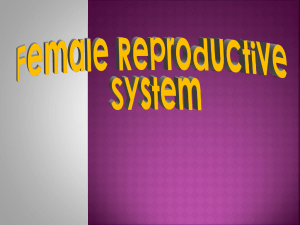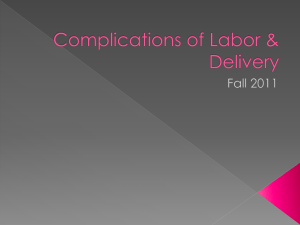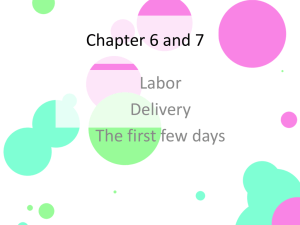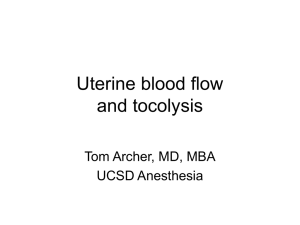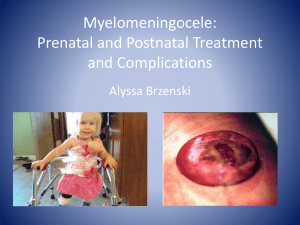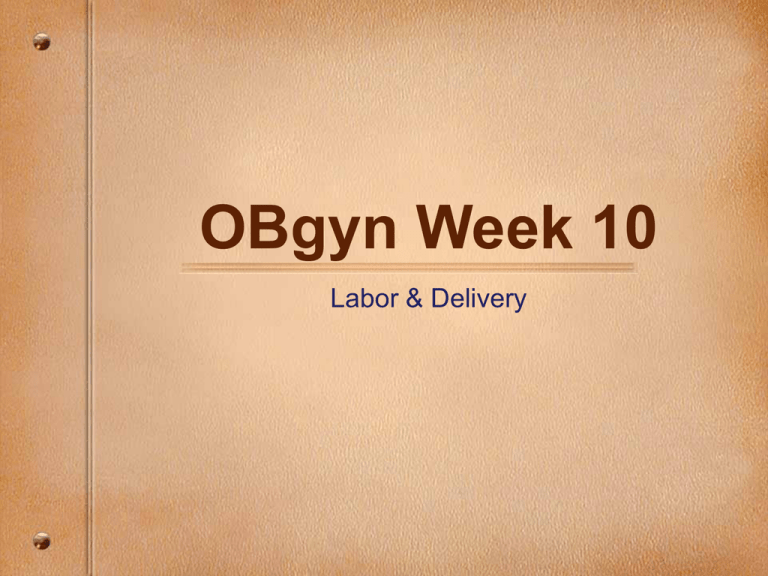
OBgyn Week 10
Labor & Delivery
Birth Practitioners
Who can deliver the baby?
• Obstetrician-Gynecologists
• Maternal-Fetal Med Specialists
• Family Practice Physicians
• Midwives
Phases of Labor
– Stage 1 (early labor and active labor)
– Stage 2 (birth of baby)
– Stage 3 (birth of placenta)
– (Stage 4 (uterine recovery))
– Post-partum
Stages of Labor
QuickTime™ and a
TIFF (Uncompressed) decompressor
are needed to see this picture.
Early Labor
• What initiates labor onset?
Labor initiation theories:
– Baby-initiated
Fetal pituitary signals fetal adrenals
Adrenals secrete cortisol-type hormone
Released into amniotic fluid via fetal urination
Absorbed into maternal blood stream
Stimulates maternal pituitary release of oxitocin
Enters maternal blood stream, stimulates uterine contractions
Labor initiation theories
Mom-initiated
– Uterus reaches specific size that causes contractions
due to stretching of muscle fibers (& oxytocin release)
– ANS signal that stimulates contractions
– Drop in progesterone right before labor removes
block to uterine contractions
Weather-initiated
– More babies born when barometric pressure drops
suddenly (eg during snow or rain storm)
Most likely a combination of factors.
(Physiology of Labor Onset)
• Physiology of cervical ripening and initiation
of UC (uterine contractions)
– Oxytocin produced and released by pituitary into
maternal bloodstream throughout pregnancy
• Large # oxytocin receptors in uterus - # of receptors
grows as pregnancy progresses.
– Late PG increase in oxytocin 500% due to uterine
stretching and increase in E:P
• Estrogen increases relative to progesterone in 2nd
trimester
• E increases concentration of oxytocin receptors in uterus
• Affects cytokine and prostaglandin production that
causes cervical ripening (soften, thin out, and dilate)
Labor Onset: S/Sx
– Pre-labor = regular uterine contractions
without cervical change
– True labor = regular contractions that
cause cervical change and continue until
baby is born
– Stalled labor = strong regular contractions
with cervical change followed by halt in
cervical change and descent of baby
Rupture of Membranes
• Membrane rupture aka “water breaking”
– Can occur before, during or even after
baby is born
• Concern for infection rises the longer it
is between membrane rupture and labor
– Consider prophylactic antibiotics, esp. if
mom is beta-strep positive
Labor Onset: S/Sx
• SROM= spontaneous rupture of membranes
– Mom can feel fluid leak either as a gush or trickle
– May be confused with urine incontinence or
vaginal fluids
– Fluid should be clear and smell slightly of
seawater
– Watch for presence of meconium in amniotic fluid:
starts as dark brown/black and goes pale green
over time (may indicate fetal distress)
– Maintain hygiene carefully after rupture: nothing
inserted into vagina, clean well after urination &
bowel movements
Meconium
• Thick, dark green, very sticky, tar-like
substance that lines fetal intestines.
– Not usu released until after birth
– If released before birth, mixes with amniotic fluid
– More chance of release if post-term
– Degree of release (color of amniotic fluid) helps
determine action - from monitoring only to
amnioinfusion and neonatal airway suction
• Aspiration of meconium can --> pnemonia
Meconium
• Baby will normally
pass meconium in
first few BMs after
birth
• Oiling baby’s bottom
beforehand can help
to remove this very
sticky substance
Qui ckTi me™ and a
TIFF (Uncompressed) decompressor
are needed to see this pictur e.
More S/Sx of Labor Onset
– “Bloody show”: pink-tinged mucus (from a bit of
blood), caused by cervical effacement and/or
dilation; capillaries break and mix with mucus
– Mucous plug: inner os filled with plug during PG; is
usually yellowish-brown. May lose this before or
during labor and is a sign that the cervix is changing
– Diarrhea / loose stools as body prepares for labor
– Low back and butt pain, urge to poop that is
nagging and won’t go away
Abnormal SX to watch for
• Important for mom to monitor for:
– Cessation of fetal movement for > 12 hours
– Any vaginal bleeding (more than Bloody
Show)
– Marked edema or h/a
– Dizziness
– Visual changes
Contractions During
Early Labor
• Pre-labor contractions vs Braxton-Hicks
• B-H: usu felt in lower abd, cervix or back
–
–
–
–
Doesn’t tend to include fundus or upper abdomen
Tend to be irregular, but can get regular
Do not lead to dilation, effacement, or descent
Generally are not painful
Labor Progression
Terminology
– Dilation: distance from one side of inner os to the
other side; 0-10 cm
– Effacement: depth of cervix (0-100%)
– Station: degree of descent; how far baby’s head is
into vaginal canal (ischial spine as landmark)
• Range is from -5 (above spines) to +5 (below spines:
crowning)
• Measured at the farthest point you can touch on either
side of baby’s head (biparietal diameter)
Fetal Descent Stations
First Stage of Labor pt 1
Early phase: 0-4/ 5 cm dilation; effacement varies
– Contractions at regular intervals causing dilation
(interval measured from beginning of one contraction
to beginning of next)
– Contractions often 5-10 minutes apart, lasting 30-45
seconds; gradually getting closer and longer
– Baby’s head may be descending
– Woman can often talk through these, esp. early on
• Mom should rest if she can to help save her energy for later
• If at home, can continue to eat and drink
• Good time to walk / climb stairs / do lunges / slow dance
(with assistance/support)
First Stage of Labor pt 2
• Active phase
– Starts at 4/5 cm to complete dilation
– Intervals usually less than 4 minutes, duration
more than 45 seconds.
– Contractions much stronger, closer together
– Baby should be starting to descend
– Bag should be bulging with the strength of uterine
contractions
– Whole uterus involved in contraction in
coordinated effort to push baby out.
Active Labor
• Transition is the part of the active phase when
cervix dilates from 7-10cm
– Usually more painful contractions, more intense,
much closer together, little rest in between
– Mom may get chilly, spacey, flushed, emotional,
want to be alone or have someone there for every
contraction, n/v
– Coaching support extremely important at this stage
Symptoms during Transition
• Factors causing these symptoms:
–
–
–
–
–
Hormones: oxytocin release
Pressure on nerves
Dilation of birth canal from baby’s head
Pain medications (epidural)
Signs of 2nd stage being near: start hearing
bearing-down efforts, desire to push, feel as if
about to have BM (b/c pudendal nerve gets
pressure which gives the urge to push)
Length of Labor
• Labor stage length averages
1st stage
2nd stage
3rd stage
Primip
11-14 h
45-80 mins
15 mins
Multip
7.5 h
20-30mins
5-15 mins
Amt of time labor takes all together depends upon whether she’s a first
time mom or not.
Stage 1
• Practitioner’s activities in First stage:
– Determine if labor has begun: internal vaginal
exam checks for dilation, station, effacement,
membranes (intact or not)
– Vitals and FHT (fetal heart tones)
– Enema for mom if she desires/if necessary
– Baths can help relax muscles but not a good idea
before 5 cm dilation because it can stall labor
– Pressure or massage to back, feet, shoulders
– Encouragement
• In many hospital settings a L&D nurse responsible for
most of these activities
Stage 1
• Fluids/ food
– During a hospital birth, will have IV fluids/ lactated
ringer’s solution (electrolytes) and ice chips
– During a home birth, woman allowed to eat
(simple, bland foods best) and drink water or
electrolyte drink
• Encourage frequent urination
• If in hospital mom will have catheter
• Toilet a good place to have contractions
(sense of letting go, she’s used to letting go there)
Stage 1 - Positions
• Positions
– Home birth/Birth Center: allows for
ambulation; help mom find comfortable
positions: walking, leaning, use pillows, as
long as FHT respond well to positions
– Hospital: change from side to side, but
confined to bed because is hooked up to IV
and monitors
Stage 1 - Breathing
• Breathing
– Not very formalized anymore
– Have mom breath comfortably
– Lamaze breathing helps give mom/dad something to
concentrate on
– Make sure mom not hyperventilating or holding her
breath
– Premature urge to push may require coaching mom
to pant to prevent pushing on the undilated cervix
Stage 1
• Monitor:
– PE: progression of dilation, effacement, station
– Duration and interval of uterine contractions
– FHT: baseline is 120-160bpm, which usually
change during contractions
• Late deceleration: gradual decrease of FHT during
contractions; drop is after peak of contraction; degree of
severity is associated with the length of return to baseline
• Sign that baby is not tolerating stress of contractions well
Stage 2
Commonly called the “pushing” stage
• Two parts of 2nd stage:
– Phase one: passive fetal descent
• Complete dilation of cervix before pushing
• Part of baby that is presenting is rotating to best possible
position for delivery
• Urge to bear down becomes reflexive when baby
descends into pelvis
– Phase two: expulsive phase
• Pushing or bearing down until infant is delivered
• Begins after fetus has descended and rotated into proper
position
Stage 2 - positions
• Positions: anything ok as long as it makes
mom comfortable and FHT remain normal
• Birth chair: advantage of gravity and can move legs
• Squatting: with support under arms (1 person on either
side), good for end pushes
• Semi-reclined: least advantageous, good if labor is too
quick as it helps slow it down
• Hands and knees: helpful if pelvis small, great for shoulder
dystocia
• Side lying: common with epidural, slows deliver, helps
prevent tearing
Stage 2 - positions
– Advantage of upright v supine positions: upright
preferred by mother, shorter 2nd stage, reduction in
episiotomies, fewer FHT abnormalities
– Disadvantage of upright: increase in 2nd degree
lacerations
– Advantages of being mobile: increased placental
perfusion, optimize fetal alignment and descent,
shorter 2nd stage, fewer episiotomies, lacerations
and FHT abnormalities, less severe pain,
squatting increases pelvic space and avoids
compression of vena cava
Stage 2 - positions
• Lateral delivery: fewer lacerations, good
placental perfusion
• Birthing chairs disadvantages:
increased perineal edema, lacerations,
and blood loss
Stage 2 - pushing
– Premature urge to push is sometimes felt
by women before complete dilation
– Common with occiput posterior (OP –
faced the wrong way) babies because
occiput presses on rectum
• Prolonged pushing can cause cervical edema,
cervical laceration, and exhaustion of the mom
• If baby in other positions and if dilated to 8-9
cm let woman push as her body guides her
Stage 2 - Fetal Heart Tones
• Normal FHT patterns
– FHT increases with contractions – they get a little
stressed here.
– Variable decelerations: FHT not matching
contractions usually due to cord compression. Ok
as long as baby recovers to baseline each time.
• Monitor closely if
– Decelerations down to 80-100 while pushing;
should come back to baseline after mom stops
pushing when contraction done
– Abnormal FHT: change position, if no
improvement, delivery necessary (or transport if at
home)
Stage 2 - breathing
• 2nd stage breathing
– Have mom do what feels right
– Coached pushing: Valsalva technique
• Push as if having a BM
• Hold breath while pushing after taking in a deep breath
• Aim is for 3 pushes per contraction; longer pushes with
quick breath in between are more effective than short
pushes
• If making noise during push, not doing it correctly
• Rest in between contractions
• Only push during contractions
• Offer mirror for “self-directed” pushing
Stage 2 - support
• 2nd stage coaching
– Emotional support:
• Encourage the mother, tell her she can do it
• Decreases catecholamines due to stress, fear
• Prevents decreased uterine contractions due to
catecholamine release
• Decreases need for pain meds
• Shorter labor
• Decreased need for instrumental or cesarean
delivery
• Supports woman’s bodily functions
Stage 2 - support
• 2nd stage coaching techniques
– Encourage woman to delay pushing until her body
directs her to (difficult if epidural), usually at +1 or
+2 station
– Direct mother’s pushing efforts when necessary
(when don’t appear to be effective)
– Help her into positions of her choice, encourage
changes every 20-30 minutes
– Reassure her intensity of sensations are normal
– Make her aware of her progress (provide
feedback) b/c she can’t see what she’s doing and
what’s going on.
Stage 2 - Labor Dystocia
• Labor Dystocia or Failure to Progress
– Ferguson Reflex (bearing down during
contraction) may be delayed or premature
• Delayed: usually contractions further apart
– Let mom rest if no urge to push
– Can stimulate urge by squatting, pressing on
posterior vaginal wall, other techniques
Failure to Progress
• Premature Ferguson reflex
Avoid pushing if cervix not fully dilated!
• Causes cervix to swell and decrease dilation
• Causes intrauterine pressure to rise,
decreasing fetal oxygenation
• Can overstretch ligaments supporting fetus
• If urge is uncontrollable, let her uterus push
without using abdominal walls and diaphragm
Stage 2 - ease
• Factors affecting length and degree of ease
of 2nd stage
– Strength and coordination of contractions
– Strength and ability of mom’s pushing effort
• Weak abdominal muscles, unwillingness to push hard,
mom exhausted
– Resistance of lower birth canal: outlet contraction
or rigid perineum
• Higher in primips
• Athletes/dancers have well-toned mm which don’t relax
easily
• Full bladder or rectum
• Malpresentations
Induction of Labor
• 5% of primips do not have natural cervical
ripening and may require induction
• Several methods to do so:
– Herbs, acupuncture, homeopathy (Gelsemium)
– Breast stimulation, foley catheter, prostaglandin gel on cervix,
stripping of membranes, amniotomy (artificial rupture of
membranes)
– IV pitocin
Induction of Labor
– Over 60% of labors in US are induced
– C-section rate in hospital for failed inductions
around 60%
– Indications:
•
•
•
•
•
•
•
Post dates
PROM
PIH
Fetal distress
Significant antepartum hemorrhage
Macrosomia (very large baby)
Patient or doctor convenience – weird western
convenience thing.
Contraindications to
Induction of Labor
– True CPD (cephalopelvic disproportion – rare –
head “too large” to exit cervix. Measure pelvic
spines to determine.)
– Abnormal presentation which prevents vaginal
delivery
– High station
– Fetal distress
– Placenta previa – placenta across cervical
opening
– Cord presentation
– Invasive carcinoma of the cervix
– Gestational age <37 weeks or >42/43 weeks
(primip/multip)
Stage 2 - Delivery
– Progress checked with sterile glove
– Perineal stretching with mineral or olive oil:
massage from internal introitus with two
fingers
• Also good to do prenatally in last 6 weeks of
pregnancy, 5 min daily
• Minimizes tearing at delivery
– Also hot compresses (add betadine to hot
water) hold on perineum and intoritus
during or between contractions
Delivery - perineal stretch
• Delivery of the head should be slow to
give the perineum time to stretch
• Counter pressure with flexion of baby’s
head toward perineum and away from
urethra and clitoris
• Have mom moan during contraction
(instead of holding breath) to help slow
down delivery
Delivery - cord check
• Check for cord after delivery of the head
– Nuchal cord is when the umbilical cord is
over head and around neck
– If enough slack, can be lifted around head
– Special maneuvers to deliver through cord
– Cord can be clamped and cut early if
necessary
• Baby needs to be delivered quickly if cord
around neck
Delivery of Head
QuickTime™ and a
TIFF (Uncompressed) decompressor
are needed to see this picture.
Delivery - body
• After head is delivered, ideally the rest
of the baby should be out on the next
contraction if possible
• Restitution: baby usually rotates on its
own so that shoulders can be delivered
Delivery - care of infant
• Immediate baby care
– Skin-to-skin contact with mom will help with
temperature regulation, bonding, and vitality
– Have ready: bulb syringe, blanket, cord clamp kit
– Drying off baby can stimulate breathing, circulation
– Suction baby’s nose and mouth
– Baby wrapped in clean blanket, hat put on (cannot
regulate body temp well first few days of life)
– Less focus these days on removing vernix
(coating around the baby – very moisturizing)
Neonate
QuickTime™ and a
TIFF (Uncompressed) decompressor
are needed to see this picture.
Neonatal Assessment
• APGAR scores assessed at 1 and 5 minutes
• Baby given a 0-2 points in 5 categories,
added together
–
–
–
–
–
Appearance
Pulse
Grimace
Activity
Respirations
– 7-10 is good; anything under 7 requires emergency efforts
Umbilical Cord
• When to clamp / cut cord
– Wait until cord stops beating, unless baby needs
to be moved quickly
– Especially if baby premature or has been in any
type of distress
– Blood ends up in baby instead of in placenta
– Proponents claim it prevents a variety of birth
injuries, from autism, hypoxia, cerebral palsy,
mental retardation
Umbilical Cord
• Cord clamping
– First clamp is placed about 1 inch from baby’s
umbilicus second clamp is about three inches from
baby
– Cord cut in between both clamps
– Cord clamp stays on for 24 hours, then cut off,
leaving stump
– If need blood sample, can get it from the end of
cord
– Cord stump dries and falls off in 7-10 days; baby
should not be submerged in water (bath) until this
has occurred
Stage 3
• Third stage of labor = delivery of placenta
– Usually within 5-15 minutes after baby is delivered
• Placental shearing: uterus becomes firmer as
muscles contract
– If uterus is still boggy, means muscles are not
contracting, either due to uterine inertia or atony
• Sudden blood gush: blood vessels are open
during birth and close off suddenly after
placental delivery
Stage 3
• Signs of placental shearing
– Uterus rises in abdomen as placenta is no longer
holding it down
– Cord lengthens as placenta starting to descend
and separate
– If placenta shears from uterus only partially,
greatest risk for hemorrhage as uterus can not
fully contract vessels
• As long as mom not hemorrhaging, wait until
placenta delivers naturally
Stage 3
• If placenta not delivering and there is
no hemorrhage
– Acupuncture, homeopathy, herbs
– Have mom squat and push for a couple of
minutes
– Nipple stimulation (baby to breast)
– Milk the cord to squeeze out blood
– After 60 minutes intervention may be
necessary
Placenta
• Placenta examination
– Make sure no pieces are retained
– Ensure proper cord implantation
– Vessels: check for 2 arteries and one vein;
if not, may be a sign of congenital
abnormalities (e.g. renal agenesis)
– Size, smell, color, calcifications, weight all
may be associated with specific conditions
Checking
the Placenta
QuickTime™ and a
TIFF (Uncompressed) decompressor
are needed to see this picture.
QuickTime™ and a
TIFF (Uncompressed) decompressor
are needed to see this picture.
Placenta
• (Placental abnormalities)
– Placenta succenturiata: one or more small
accessory lobes which may be retained in uterus
– Placenta membranacea: a large, thin,
membranous placenta that surrounds the fetal
membranes. Associated with retention and
hemorrhage
– Circumvallate placenta: doubling of amnion and
chorion; possibly associated with undiagnosed
amnionitis, PROM
• Bottom line: placenta should be inspected for
abnormalities
Placenta
• (Placental abnormalities)
– Placenta accreta: placenta implants deeply in
uterine wall; little or no bleeding after birth of baby
• Increta: more deeply inserted into uterine wall
• Percreta: insertion though the entire uterus
• If interventions to remove placenta, increased risk of
hemorrhage; also higher risk for infection and DIC.
• May require hysterectomy
Hemorrhage
• Blood loss during delivery
– Normal: 250-500ml
– Over 500ml is considered a hemorrhage
– If mom asymptomatic and bleeding stops, not
worrisome
– Monitor for shock: pallor, dizziness, chilliness,
eyes rolling back, shaking
Stage 4 / post partum
• After normal delivery of placenta
– Uterus is checked periodically to make sure it is
firm (prevent hemorrhage)
– 1 cup of fluids every hour she’s awake
– Stay in bed 2 days minimum, getting up only to
use bathroom
– May shower 12 hours post delivery
– Watch bleeding: slight dripping ok, steady stream
or gush sign of hemorrhage = emergency
Post Term Pregnancy
• Post Term or Post Dates = 42 weeks or
more
– Increases risk to the mother and baby
• Risk: neonatal mortality and stillbirth
rates are 3x higher with post term
pregnancy due to placental failure
• Incidence: about 6-12% deliver at 42
weeks or after
Post term pregnancy
• Inadequate placental function may lead to:
–
–
–
–
–
–
–
Asphyxia
Diminished amniotic fluid level
Dry and peeling skin (baby) b/c vernix washes off
Absence of subcutaneous fat on infant
Increased risk of umbilical cord entanglement
Low blood sugar and low clotting factors in baby
Increase risk for cesarean birth
Post term pregnancy
• Etiology
– Most common: failure of cervix to soften (ripen)
– High doses of aspirin or other prostaglandin
inhibitors prohibit cervical ripening
– Lack of stimulatory factors such as oxytocin and
prostaglandin
– Abnormal fetus
– Psychological factors
– Stress and fear can also inhibit labor
Post term pregnancy
• Management
– Induction of labor (usually with pitocin)
– Some doctors will induce as early as 41
weeks
– If any complications, even if mild, need to
induce
Malpresentations
• Breech: sacrum presenting first
– Frank: flexed thighs and extended legs
(butt downward, feet up)
– Complete: flexed thighs and legs – sitting
“Indian” style
– Footling: extended thighs and legs
One of most dangerous presentations –
foot comes out first, baby will not fit
through the opening.
Breech Presentations
Malpresentations
• Etiology:
– Less room in the pelvis
– Large fetal head
– Prematurity
– Polyhydramnios
– Placenta previa
– Low uterine fibroids
– Twins
Malpresentations
• Diagnosis
– Before labor usually by week 34 ultrasound
– During labor during speculum exam
• Risks
– Fetal mortality- up to 25%
– Delivery trauma
• Nervous system, abdominal injury, cord
prolapse, congenital abnormalities, prematurity
Malpresentations
• Cesarean delivery indicated
– Prematurity
– Pelvic contracture
– Hyperextension of fetal spine or head
– Footling breech
– Dysfunctional labor
– Previous prenatal death
– Frank breech vaginal delivery still possible
Malpresentations
• Face presentation
Malpresentations
• Brow presentation (partially extended
head)
Malpresentations
• Shoulder presentation:
– Transverse lie
Malpresentation
• Compound presentation
Malpresentation - OP
• Occiput posterior (OP): vertex presentation
with the fetal occiput facing maternal spine
– Occurs in 6-10% of labors
– Etiologies
•
•
•
•
Poorly flexed head
Flat sacrum
Ineffective uterine contractions
Epidural– decreased pelvic floor muscle tone
Malpresentations - OP
Malpresentation
• Characteristics of OP labor
– Slow progress in dilation and descent
– Mild to severe back pain
– Uncoordinated contractions
– Urge to push before second stage
– Bulge in sacral area
Malpresentation
• Management of malpresentations
– Many techniques to assist rotation
– Prevention before labor: pelvic rocks,
hands and knees, avoidance of supine
position, lying in different positions;
ambulation
– May require interventions: forceps, vacuum
extraction, C-section
Forceps
• Prerequisites for forceps delivery:
–
–
–
–
–
–
–
Proper presentation, position and station
Fully dilated cervix
Head position is known
Minimal CPD (cephalopelvic disproportion)
Membranes ruptured
Adequate anesthesia and facilities
Competent operator
Forceps
• Benefits of forceps delivery
– Assists difficult labor
– No increase in fetal morbidity
• Risks
– Maternal lacerations, bleeding, perineal tear/ need
for episiotomy, fecal incontinence (damage to
rectal sphincter)
– Neonatal: forceps marks on face, facial nerve
injuries, intracranial bleeding, cerebral palsy
– Statistics complicated because done only in cases
of difficult, prolonged labor
Vacuum Extraction
• Prerequisites for vacuum extractors
– Term infant
– Vertex presentation
– Engagement of fetal head to 2+ station
– Ruptured membranes
– Full cervical dilation
– Minimal CPD
Vacuum Extraction
• Indications
– persistent occiput posterior, malposition of fetal
head, exhausted mother, fetal distress
• Use discontinued if disengagement of vacuum cup,
failure to deliver head within 10 minutes of accrued use
or 30 min total use (no suction in between contractions)
• Complications
– Maternal: vaginal lacerations from improper use
– Fetal/ neonatal: scalp abrasions, bruising,
cephalohematoma, hemorrhage, jaundice if
excessive bruising
Assisted Birth
Epidural
• Epidural Anesthesia blocks labor pains
without causing fetal respiratory distress
–
–
–
–
–
–
–
–
–
Does not always block pain
Does not allow natural maternal endorphin release
Often stalls labor
Requires need for constant fetal monitoring thus
limiting maternal mobility during labor
Requires urinary catheterization, risk for UTI
Can suppress contractions --> need for pitocin
Can cause fetal malposition into OP position
Increases need for C-section
Mother can’t feel what an effective push during a
contraction feels like
Pitocin
• Pitocin is synthetic Oxytocin
Oxytocin:
• Stimulates labor contractions and milk let-down
• “Love hormone”, promotes bonding
• Suppressed by adrenalin
• Release supported by dim light, privacy,
supportive talk
Pitocin
• Pitocin adverse effects
– More painful uterine contractions
– Does not cross BBB, no effect on bonding
– Given as continuous drip (oxytocin
naturally released in pulsatile manner);
needs a higher dose to achieve effect
– May cause fetal distress
Problems during Labor
• Premature labor is onset < 37 weeks
gest with contractions that lead to
dilation
• Etiology
– Incompetent cervix: won’t stay firmly
closed
– Over distention of the uterus
– Infection
– Psychological stress
Problems during Labor
• Etiology of premature labor continued
– Stimulation (nipple stim or bowel irritation)
– Very poor nutrition
– Fetal malformation
– Antepartum hemorrhage
– Congenital malformations of the uterus
– Artificial induction
Problems during Labor
• Premature labor
– Need to ddx from Braxton-Hicks
– Any event that can have induced labor?
(overexertion, excessive GI stimulation)
– Needs careful monitoring: bleeding, infection
– May require drugs given in hospital to stop
contractions
– Natural treatment: bed rest, herbs to relax uterus,
warm baths, water, remove underlying cause,
homeopathy, acupuncture
Problems during Labor
• Dystocia = difficult or abnormal labor
– Shoulder dystocia: impaction of baby’s shoulders
in maternal pelvis after head delivery; lodges
above pelvic bone
– Is an emergency: 6-8 minutes before brain
damage
– Incidence: 1/100 births, 1.7% babies > 8.5#
– Etiology: CPD, failure to rotate, baby’s hand
behind his back, broadening the shoulders
Shoulder Dystocia
• Diagnosis of shoulder dystocia:
– Prenatally: diabetic moms, small mom and large
dad, ultrasound, history of large babies, hx of
shoulder dystocia
– Interpartum: long, hard labor despite good quality
contractions, long slow pushing despite good effort
– Warning signs at birth: head delivers slowly, can’t
find neck
– Management involves different maternal positions
Umbilical Cord Problems
• Prolapse
– Occult: cord lies beside the presenting
body part
– Frank: cord below presenting part with the
membranes ruptured; may or may not be
preceded by cord presentation (cord below
presenting part with intact membranes)
– Incidence: <1%
Cord Prolapse
• Risk factors
–
–
–
–
–
–
–
–
Fetal malpresentations
Multiple pregnancies
Malformations
Prematurity
Polyhydramnios
Placenta previa
Uterine fibroids, congenital malformations, laxity
Iatrogenic: intrauterine manipulation
Cord Prolapse
• Diagnosis
– Palpation
– Abnormal fetal heart tones (variable decels with
cord prolapse)
– Passage of meconium
– Best to prevent by not rupturing membranes
before presenting part engaged
– May require C-section
Umbilical Cord Problems
• Cord entanglement
– Incidence around neck common: 30%
• Incidence of multiple loops very low
– Etiology: long cord, excess fluid, combination;
related to freedom of fetal movement
– Common in monoamniotic twins (2 cords, one
sac)
– Complications: compromise to umbilical blood
flow, failure of descent of head, low APGAR
Umbilical Cord Problems
• Short cord
– Absolute: < 30cm
– Relative- due to looping around fetus
– Complications: fetal distress, fetal death,
placental abruption, breech presentation,
delayed onset of labor, occasional cord
rupture
Umbilical Cord Problems
• Cord knotting
– Incidence: 0.5% with occurrence as early
as 1st trimester
– Etiology: similar to entaglement, occurs
accidentally dt fetal activity, more common
in male fetuses
– Usually does not tighten until descent of
the presenting part of labor
– Complications: fetal distress 15%, lower
APGAR, perinatal death rate increased 5x
Problems during Labor
• Meconium aspiration
– Asphyxia stimulates the vagus nerve (supplies
intestines), producing peristalsis, relaxation of anal
sphincter, release of meconium
– If in baby’s mouth / nasal passages, can enter
lungs on first inhalation
– Very sticky - interferes with lung inflation and can
lead to infection, pneumonia
– Suction airways to reduce risk of aspiration
– Requires O2 administration
Meconium release usu stress reaction
• Hypoxia (cord accident or other reason)
• Incidence: 10-15%
Other topics - VBAC
• VBAC: Vaginal Birth after Cesarean
– 60-80% of women can have VBAC
– ACOG recommendation: based on clinical
circumstances and the patient’s choice after
appropriate counseling of potential risks
– Types of incisions:
• Low transverse: horizontal cut made across the lower,
thinner part of uterus – better for VBAC?
• Low vertical: vertical cut made on the lower part of uterus
• High vertical/ classical: vertical cut upper uterus; highest
risk of rupture
Other topics - VBAC
• Benefits of VBAC
– Less morbidity
– Fewer blood transfusions
– Fewer post partum infections
– Shorter hospital stay
– No increase in perinatal morbidity
– Emotional advantages from achieving
vaginal birth
Other topics - VBAC
• VBAC contraindications:
– Prior classical incision or T scar
– Transfundal uterine surgery
– Contracted pelvis
– Other medical complications or
contraindications for vaginal delivery
Other topics - VBAC
• VBAC relative contraindications
– Multiple low transverse incisions from previous
C-sections
– Unknown uterine scar
– Breech presentation
– Twin gestation
– Post term pregnancy
– Suspected macrosomia
– Prostaglandin use for induction is associated
with high risk of uterine rupture in VBAC patients
Other topics Uterine Rupture
• Uterine rupture
– Incidence increased with use of labor induction
and augmentation; predominance in multiparous
women
• 1/8000-15,000 women will have spontaneous rupture of
unscarred uterus
– Predisposing factors: poor surgical technique on
uterine incisions, poor management of
hemorrhage causing hematoma and infection
– Precipitating factors: uterine overdistention,
dystocia
Other topics Uterine Rupture
• Uterine rupture signs/ symptoms
– Sudden severe FHT decelerations are most
reliable sign of uterine rupture
– Sharp, sudden, tearing pain
– Faintness or actual collapse
– Vaginal bleeding or signs of internal bleeding
– Loss of fetal station
– Change of dilation
– Fetal demise likely
Other topics Uterine Rupture
• If rupture in lower segment of uterus
– Ache or pain in lower abdomen
– UC decrease or cease
– Less bleeding due to less vascularity of lower
uterus
– Fetal distress
– Diagnosis may be after manual removal of
placenta or hysterectomy
– May be hemorrhage
– Patient decline
Other topics Uterine Rupture
• Treatment:
– O2 administration to mother
– Treat shock
– C-section to save baby
– Antibiotic therapy
– Usually hysterectomy or possibly uterine
repair
Good Resource
• Book - The Labor Progress Handbook
by Penny Simkin et al
e-version (limited):
http://tinyurl.com/5dkmur
If you are interested in this subject, this
is a great book to own


